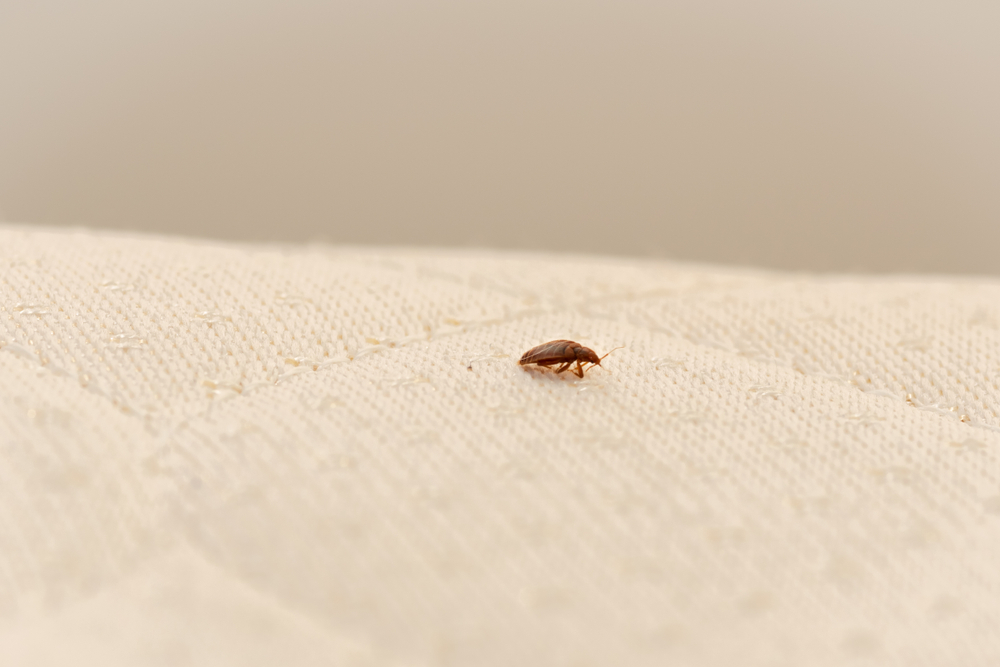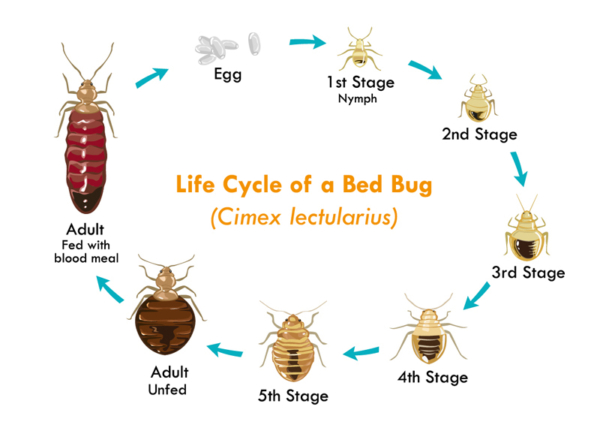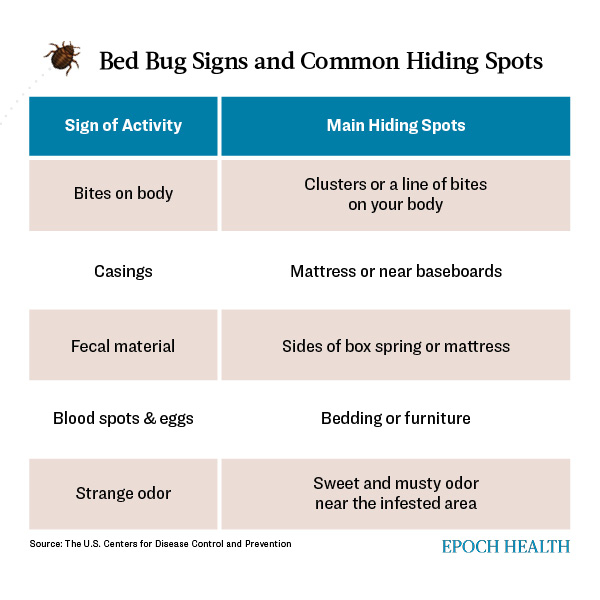


In her early 20s, Jenny resided in a dorm in New York City. To her horror, she found several bed bugs on her bed one day. “All the people living in the dorm immediately evacuated,” Jenny said.
Bed bugs are unwelcome hitchhikers that resist eviction. They infest beds, hotels, and even movie theaters. These crafty critters lurk everywhere, from high-end hotels to slums. They’ll hitch a ride in your luggage and travel home with you.
Battling them feels like a never-ending game of hide-and-seek. Getting rid of them can be difficult and costly, but not impossible.
Bed bugs are small, reddish-brown, flattened parasites that feed on blood. They lack wings, can survive for weeks to a year (pdf) without feeding, and measure between 1 and 7 millimeters in length.
In their lifetimes, female bed bugs, depending on the species, can lay 50 pearl-white eggs in cracks and crevices, though they can lay as many as 500. They shed their skins five times before growing to maturity. Adult bed bugs are brown and oval-shaped when unfed, turning reddish-brown and elongated after feeding.
Although bed bugs don’t spread diseases, they can be irritating and cause various skin conditions. Their bites can result in small, red, itchy bumps, often in lines or clusters.
Different people react differently to bed bug bites. Some experience no symptoms, while others may have allergic reactions with intense itching, enlarged bite marks, swelling, and even anaphylaxis.
Excessive scratching of the itchy bites can lead to secondary skin infections like impetigo, ecthyma, and lymphangitis.
Bed bugs are notoriously difficult to remove for several reasons.
Bed bugs are often introduced into homes from infested places you’ve visited. They can also migrate from neighboring units in apartment buildings or condos.
Due to bed bugs’ prolific reproductive capacity and “the fact that bed bug removal can be costly, it is imperative that you focus on preventing an infestation in the first place,” Ben McAvoy, co-founder of Insectek Pest Solutions in Phoenix, Arizona, told The Epoch Times.
There are several ways to keep bed bugs away from your home:
“For prophylactic measures, use essential oils like lavender, peppermint, tea tree, or lemongrass mixed with carrier oil,” Nicole Carpenter, CEO of Black Pest Prevention, told The Epoch Times. “Apply this mixture around your bed’s legs and furniture to create a natural barrier. Alternatively, place bed bug-repelling plants such as lavender, mint, rosemary, or marigold near your bed.”
Plant essential oils consist of intricate combinations of chemical constituents derived from aromatic plants. They have been suggested as an alternative method for bed bug control.
According to a study by Purdue University, essential oils such as carvacrol (derived from oregano and thyme), thymol (from thyme), citronellic acid (from lemongrass), and eugenol (from clove) were found to be very effective at repelling bed bugs. Specifically, thymol, carvacrol, and eugenol could depress the bugs’ nervous systems.
“Keeping a set of shoes or slippers solely for indoor use, since footwear worn outside can track bed bugs, eggs, or larvae, can also aid in keeping your home bed bug-free,” Allan Bossel, owner-operator of Michigan Bed Bug Specialists, told The Epoch Times.
In addition, you can take off and wash your outdoor clothes on high heat immediately after coming home, if possible, according to Carlie Gasia, certified sleep science coach at Sleepopolis, told The Epoch Times.
“The most likely place you will pick up bed bugs is hotels, short-term rentals, and any other public place where seating is involved, such as movie theaters,” Mr. McAvoy said. “An easy inspection of the hotel bed, furniture, and additional general seating can uncover bed bug activity.”
Be careful when introducing used furniture, particularly upholstered pieces, into your home. Thoroughly inspect them for bed bugs, as they may hide within. Banning secondhand furniture in group accommodations can help minimize the risk of bed bug infestations.
Ms. Gasia also advised to “regularly clean and vacuum your home, paying attention to cracks, crevices, and furniture seams,” and to “encase your mattress, box spring, and pillows in bed bug-proof covers.” Furthermore, you should check regularly for any signs of bed bugs.
There are clear indications of bed bug activity to watch out for: clusters or a line of bites on your body, casings found on the mattress or near baseboards indicating the bugs’ molting process, and fecal material on the sides of your box spring or mattress, according to Megan Wede, co-owner and co-operator of Done Right Pest Solutions.
There are a few steps to take if you uncover a bed bug infestation in your home:
“Wash and dry your bedding, clothes, and other washable items on the highest heat settings possible to kill any potential bed bugs,” Ms. Gasia said. “If it’s too late to prevent them, freezing infested items for several days can also eliminate the bugs.”
Wash your bedding at least once a week. Research shows that bed bugs exposed to a temperature of 118 F will die within 20 minutes (pdf). However, a more prolonged exposure of 90 minutes at the same temperature is necessary to eradicate bed bug eggs.
Ms. Wede advised against seeking refuge with a family member or friend or removing your furniture before your home has been treated. Bed bugs can survive for months without feeding and can easily hitch a ride to new locations with you or your furniture.
Steam heat treatment is recommended to target bed bug-prone areas or items where any potential survivors may be hiding and reproducing.
“Full-room heat treatments with industrial-sized electric heaters can effectively raise the room temperature levels to 145 F and eliminate all bed bugs in the space,” Mr. Bossel said.
In one study, heat treatment, such as steam, outperformed chemical insecticides in effectively treating (resistant) bed bugs. Bed bug eggs exhibited a 100 percent mortality rate, regardless of exposure duration. Nymphs and adult bed bugs showed a mortality rate ranging from 88 to 94 percent.
If you have multiple bites or notice signs of infection in a bite, consult a dermatologist to treat possible infections and alleviate itchiness.
Mr. Bossel cautioned against DIY methods, as they might not result in “a thorough extermination.”
For instance, bug bombs (i.e., foggers) have proven ineffective against bed bugs. This is primarily due to the resistance of many bed bugs to the low concentrations of synthetic insecticides found in these products. Additionally, the insecticides struggle to reach the hiding spots where some bed bugs reside, further limiting their efficacy.
For additional information, refer to the bed bug webpage by the Environmental Protection Agency (EPA) or the webpage dedicated to bed bugs by the New York City authorities.
An online guide developed by Done Right Pest Solutions is also available for free.
What topics would you like to read about? Please let us know at health@epochtimes.nyc



